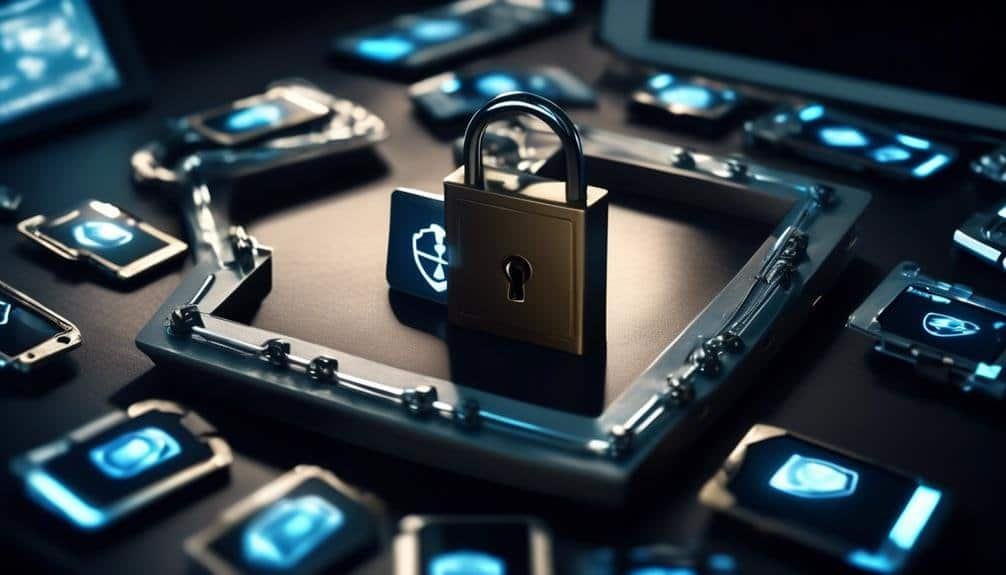Staying Safe Online: Cybersecurity Basics for Educators and Students
Imagine a vast digital landscape, where information flows freely and connections are made with a simple click. In this ever-expanding realm, where knowledge and opportunities abound, lies a hidden danger that lurks beneath the surface.
It's time to navigate the intricacies of cyberspace and equip yourself with the necessary tools to protect your digital presence. In this discussion, we will explore the cybersecurity basics that educators and students need to know in order to stay safe online.
Uncover the secrets of password security, learn how to identify and avoid phishing attacks, safeguard your personal information, and much more.
Are you ready to take control of your online safety?
Key Takeaways
- Cybersecurity training and online security awareness are essential for educators and students to mitigate cybersecurity risks.
- Strengthening password security through complexity and the use of password managers can enhance online protection.
- Identifying and avoiding phishing attacks requires proper email security measures and knowledge of common phishing techniques.
- Safeguarding personal information online involves using strong passwords, enabling two-factor authentication, and being cautious when sharing information on social media.
Understanding Cybersecurity Risks
Understanding cybersecurity risks is crucial for educators and students alike in order to protect sensitive information and safeguard against potential threats. In today's digital world, where reliance on technology is ever-increasing, it's essential to have a solid understanding of cybersecurity risks and how to mitigate them. Cybersecurity training and online security awareness play a vital role in equipping individuals with the necessary knowledge and skills to navigate the online landscape safely.
Cybersecurity training serves as a proactive approach to educate educators and students about potential threats and vulnerabilities. It aims to enhance their ability to identify and respond to cyber attacks effectively. By providing comprehensive knowledge on various types of cyber threats, such as malware, phishing, and ransomware, individuals can develop a sense of awareness that can help them make informed decisions and take appropriate actions to protect their digital assets.
Online security awareness complements cybersecurity training by instilling a mindset of caution and skepticism towards online activities. It encourages individuals to practice safe browsing habits, use strong and unique passwords, and be mindful of sharing personal information online. Additionally, it emphasizes the importance of regularly updating software and keeping systems patched to prevent exploitation of known vulnerabilities.
Strengthening Password Security
To enhance your online security, it is crucial to strengthen the security of your passwords. Strengthening password complexity and implementing effective password management techniques can significantly reduce the risk of unauthorized access to your accounts.
One of the best ways to strengthen password security is by using a combination of uppercase and lowercase letters, numbers, and special characters. This creates a more complex password that is harder for hackers to crack. Additionally, it is important to avoid using common words or predictable patterns in your passwords.
In order to manage your passwords effectively, consider using a password manager. These tools store your passwords securely and can generate strong, unique passwords for each of your accounts. They also eliminate the need for you to remember multiple passwords, as the password manager stores them for you.
Here is an example of a table that compares different password management techniques:
| Technique | Pros | Cons |
|---|---|---|
| Password Managers | Securely store and generate strong passwords | Requires trust in the password manager service |
| Two-Factor | Adds an extra layer of security | May be inconvenient for some users |
| Authentication | ||
| Biometrics | Convenient and secure | Relies on the availability of biometric data |
Identifying and Avoiding Phishing Attacks
Phishing attacks can be identified and avoided by implementing proper email security measures. Recognizing email scams is crucial in protecting against social engineering attacks.
Phishing emails often appear to be from trusted sources, such as banks or online services, but they're actually attempts to deceive you into revealing sensitive information or downloading malware. To identify phishing emails, pay attention to the sender's email address, as scammers may use slight variations or fake domains. Be cautious of urgent or threatening language, requests for personal information, and grammatical errors in the email.
Avoid clicking on suspicious links or downloading attachments from unknown sources. Instead, independently verify the information by contacting the organization directly through their official website or phone number. Educate yourself and your students about common phishing techniques, such as spear phishing and whaling, to increase awareness and prevent falling victim to these scams.
Safeguarding Personal Information Online
Implement proper security measures to safeguard your personal information online. Data protection and privacy settings are essential in keeping your sensitive information secure.
To begin, always use strong and unique passwords for all your online accounts. Avoid using common phrases or easily guessable information like your birthdate or pet's name. Instead, create complex passwords with a combination of letters, numbers, and special characters.
Additionally, enable two-factor authentication whenever possible to add an extra layer of security.
Furthermore, be cautious when sharing personal information online. Avoid providing unnecessary personal details on social media platforms or public websites. Review your privacy settings on social media accounts and ensure that only trusted individuals can access your personal information. Regularly check and update your privacy settings to stay in control of the information you share.
When using online services or making online purchases, be mindful of the websites you visit. Look for secure websites with a padlock icon in the address bar and websites that start with 'https' instead of 'http.' This indicates that the website encrypts your data during transmission, making it harder for hackers to intercept and access your information.
Using Secure Wi-Fi Networks
Make sure to connect to secure Wi-Fi networks to protect your online activities and data. When connecting to a Wi-Fi network, it's important to be aware of the security measures in place.
Wi-Fi encryption methods play a crucial role in safeguarding your information from unauthorized access. The most common types of Wi-Fi encryption methods are WEP (Wired Equivalent Privacy), WPA (Wi-Fi Protected Access), and WPA2 (Wi-Fi Protected Access 2). It's recommended to connect to networks that use WPA2 encryption, as it provides the highest level of security.
To ensure the security of Wi-Fi networks, conducting a vulnerability assessment is essential. This assessment involves identifying potential weaknesses or vulnerabilities in the network's security. By analyzing factors such as network configuration, access controls, and encryption protocols, you can determine if any vulnerabilities exist and take appropriate measures to address them.
Protecting your online activities and data begins with connecting to secure Wi-Fi networks. By understanding the different encryption methods and conducting vulnerability assessments, you can minimize the risk of unauthorized access to your information. Stay vigilant and prioritize your online security by connecting to secure Wi-Fi networks whenever possible.
Implementing Two-Factor Authentication
Now it's time to discuss the importance of implementing two-factor authentication and how to set it up.
Two-factor authentication adds an extra layer of security by requiring users to provide two forms of identification before accessing their accounts. This significantly reduces the risk of unauthorized access and strengthens your overall cybersecurity.
Setting up two-factor authentication is a straightforward process that can be done through various methods, such as using SMS codes, email verification, or authenticator apps.
Importance of Two-Factor
Using two-factor authentication is a crucial step in enhancing the security of your online accounts. It adds an extra layer of protection by requiring you to provide two different factors to verify your identity.
Here are three key reasons why implementing two-factor authentication is important:
- Increased Security: By requiring two separate factors, such as a password and a unique code sent to your phone, it significantly reduces the likelihood of unauthorized access to your accounts.
- Protection against Password Theft: Even if someone manages to steal your password, they'd still need the second factor to gain access, making it much harder for hackers to compromise your accounts.
- Defense against Phishing Attacks: Two-factor authentication helps protect against phishing attempts because even if you unknowingly provide your login credentials on a fake website, the hacker still won't have the second factor needed to access your account.
Setting up Two-Factor
To enhance the security of your online accounts, it is essential to set up two-factor authentication. Two-factor authentication adds an extra layer of protection to your accounts by requiring you to provide two pieces of evidence to verify your identity. This usually involves something you know (like a password) and something you have (like a smartphone or a hardware token).
Setting up multi-factor authentication is a straightforward process. Most online services offer the option to enable two-factor authentication in their account settings. Once enabled, you will receive a verification code via SMS, email, or through an authenticator app whenever you try to log in. You will then need to enter this code along with your password to gain access to your account.
Here is a table highlighting some of the benefits of two-factor authentication:
| Benefits of Two-Factor Authentication |
|---|
| Provides an extra layer of security |
| Protects against password-related attacks |
| Reduces the risk of unauthorized access |
Educating Students on Online Safety Measures
To ensure online safety, it's crucial to educate students on various measures.
First, teach them about online privacy and the importance of keeping personal information secure.
Second, help them identify online threats such as phishing scams and malicious websites.
Lastly, emphasize the need for strong passwords and teach them how to create and maintain them.
Tips for Online Privacy
Implementing effective online privacy measures is crucial for ensuring the safety and security of students while using the internet. Here are three tips to help you protect your online privacy:
- Use secure browsing: Ensure that you're using encrypted connections when browsing the internet. Look for the padlock symbol and 'https' in the website's URL, which indicate that the connection is secure. This helps prevent unauthorized access to your information.
- Be cautious of online tracking: Many websites and online services use tracking tools to collect data about your online activities. To minimize tracking, regularly clear your browser cookies and opt out of targeted advertising.
- Protect your personal information: Avoid sharing sensitive information, such as your full name, address, or phone number, online unless necessary. Be mindful of what you post on social media platforms and adjust your privacy settings to limit access to your personal information.
Identifying Online Threats
When it comes to educating students on online safety measures, it is essential to equip them with the knowledge to identify and protect themselves from various online threats. Two common online threats that students need to be aware of are online scams and malware. Online scams are deceptive schemes that aim to trick people into providing personal information or money, often through phishing emails or fake websites. To protect against online scams, students should be cautious of unsolicited messages, verify the authenticity of websites before providing personal information, and avoid clicking on suspicious links or downloading unknown files. Malware, short for malicious software, is designed to damage or gain unauthorized access to computers. To protect against malware, students should regularly update their antivirus software, avoid downloading files from untrusted sources, and be cautious of suspicious emails or attachments.
To help students understand and remember these important online safety measures, here's a table summarizing the key points:
| Online Threats | Tips to Protect Against |
|---|---|
| Online Scams | – Be cautious of unsolicited messages<br>- Verify website authenticity<br>- Avoid clicking on suspicious links or downloading unknown files |
| Malware | – Regularly update antivirus software<br>- Avoid downloading files from untrusted sources<br>- Be cautious of suspicious emails or attachments |
Creating Strong Passwords
Strengthen your online security by creating strong, unique passwords. Here are some key points to keep in mind when creating passwords:
- Use a combination of upper and lowercase letters, numbers, and special characters. This makes your password more complex and harder to guess.
- Avoid using common words, phrases, or personal information. Hackers often use automated tools that can easily guess these types of passwords.
- Consider using a password management tool. These tools can generate strong passwords for you and securely store them, so you don't have to remember them all.
Conclusion
So there you have it, folks! By following these cybersecurity basics, you can rest assured that your online presence is secure.
It's ironic, isn't it? In a world where technology connects us all, we must also be wary of its dangers. But fear not, for armed with knowledge and a few simple steps, you can navigate the digital realm with confidence.
Stay safe, stay vigilant, and remember, the cyber world may be vast, but so are your defenses.







